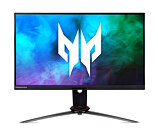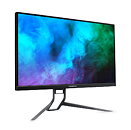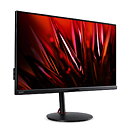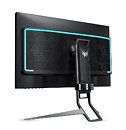Thursday, January 7th 2021

Acer Unveils Three New High Refresh Rate Gaming Monitors
Acer today unveiled a host of new products in its expanding Predator and Nitro portfolios with three gaming monitors suited to a wide range of gamers, from elite professionals requiring top-of-the line technology to casual gamers who play for fun. Additionally, Acer is the first to deliver TÜV Rheinland Eyesafe -certified gaming monitors that have been specially designed to emit less high-energy blue light than industry-standard LCDs.
"Our newest gaming monitors feature the industry's latest technology to give gamers smooth performance and comfortable ergonomics," said Victor Chien, President, Digital Display Business, Acer Inc. "Designed to appeal to the most power-hungry gamers, our Predator gaming monitors have proven their quality and reliability as a top choice of pro-gamers as well as those who just want to have fun. The new Predator and Acer Nitro monitors are available in a variety of designs and sizes to support just about anyone in the market for a gaming monitor."Predator XB273U NX
The Predator XB273U NX gaming monitor is for gamers seeking a cutting-edge gaming experience. Packed full of the latest gaming and display innovations, the 27-inch monitor brings gamesto life with a WQHD (2560 x 1440) panel, 275 Hz refresh rate (overclocked) and up to a 0.5 ms response time (G to G), allowing it to deliver smooth and tear-free visuals even when fast-moving objects race across the screen. The HDR capable monitor covers 95% of the DCI-P3 spectrum to offer vibrant colors and deeper blacks, and its display is further enhanced by Acer's Agile-Splendor IPS[2] technology that makes crystal clear images possible even at wide viewing angles.
The recently launched NVIDIA Reflex Latency Analyzer, a revolutionary system latency measurement tool that detects clicks coming from the mouse and then measures the time it takes for the resulting pixels (i.e., a gun muzzle flash) to change on screen, while NVIDIA G-SYNC provides tear-free gaming in addition to an expanded contrast ratio and color palette.Predator XB323QK NV
The new Predator XB323QK NV is a 31.5-inch NVIDIA G-SYNC Compatible UHD (3840 x 2160) gaming monitor with a rapid 144 Hz refresh rate. On top of the buttery smooth visuals that this technology entails, games look pleasantly vivid with the vibrant range of colors offered by the monitor's DCI-P3 90% Wide Color Gamut. It also includes Acer's Agile Splendor IPS and a VESA DisplayHDR 400 certification.Acer VisionCare 4.0
Both the new Predator XB3 series monitors feature Acer VisionCare 4.0, a comprehensive suite of technologies that help protect users' eyes during longer gaming sessions and tournaments. Acer VisionCare 4.0 includes LightSense, for adjusting the monitor's screen brightness based on ambient lighting, in addition to AdaptiveLight, ColorSense and ProxiSense, a suite of technologies that measures environmental and ambient light to automatically adjust the monitor's brightness and color-temperature accordingly.
Both are among the first monitors in the world to be TÜV Rheinland Eyesafe certified. They rest upon Acer's ErgoStand, an innovative stand that gives users the freedom to adjust their monitor's swivel, pivot, tilt and height in order to find the perfect viewing angle.
Acer Nitro XV282K KV
The Nitro XV282K KV immerses users into spectacular worlds in incredible detail with its 4K UHD (3840 x 2160) IPS panel, features a 100,000,000:1 contrast ratio to display sharp visuals and covers 90% of the DCI-P3 wide color gamut to allow for intense color representations. Also featuring AMD FreeSync Premium technology, the 144 Hz refresh rate panel boasts a 1 ms response time for speedy frame rendering. Additionally, the Acer Nitro XV282K KV comes with HDMI 2.1 and a cable for hassle-free support for the latest gaming consoles at 4K UHD 120 Hz with VRR (Variable Refresh Rate). The monitor has also achieved TÜV Rheinland Eyesafe certification and features Acer's new Agile-Splendor IPS technology to deliver clear images, even at wide viewing angles.
The new Acer Nitro XV2 series monitor features Acer HDR 400 and liquid crystal IPS for increased image quality, while Acer VisionCare 3.0 incorporates several technological innovations to help reduce eye strain experienced by heavy users such as programmers, writers and graphic designers. These technologies include LightSense, ColorSense, ProxiSense and BluelightShield Pro.Pricing and Availability
The Predator XB273U NX monitor will be available in North America in May starting at USD 1,099.99; in EMEA in May starting at EUR 1,179.00; and in China in March, starting at RMB 7,999.
The Predator XB323QK NV monitor will be available in North America in May starting at USD 1,199.99; in EMEA in May starting at EUR 1,199.00; and in China in March, starting at RMB 8,999.
The Nitro XV282K KV monitor will be available in North America in May starting at USD 899.99; in EMEA in May starting at EUR 949.00; and in China in February, starting at RMB 6,999.
Source:
Acer
"Our newest gaming monitors feature the industry's latest technology to give gamers smooth performance and comfortable ergonomics," said Victor Chien, President, Digital Display Business, Acer Inc. "Designed to appeal to the most power-hungry gamers, our Predator gaming monitors have proven their quality and reliability as a top choice of pro-gamers as well as those who just want to have fun. The new Predator and Acer Nitro monitors are available in a variety of designs and sizes to support just about anyone in the market for a gaming monitor."Predator XB273U NX
The Predator XB273U NX gaming monitor is for gamers seeking a cutting-edge gaming experience. Packed full of the latest gaming and display innovations, the 27-inch monitor brings gamesto life with a WQHD (2560 x 1440) panel, 275 Hz refresh rate (overclocked) and up to a 0.5 ms response time (G to G), allowing it to deliver smooth and tear-free visuals even when fast-moving objects race across the screen. The HDR capable monitor covers 95% of the DCI-P3 spectrum to offer vibrant colors and deeper blacks, and its display is further enhanced by Acer's Agile-Splendor IPS[2] technology that makes crystal clear images possible even at wide viewing angles.
The recently launched NVIDIA Reflex Latency Analyzer, a revolutionary system latency measurement tool that detects clicks coming from the mouse and then measures the time it takes for the resulting pixels (i.e., a gun muzzle flash) to change on screen, while NVIDIA G-SYNC provides tear-free gaming in addition to an expanded contrast ratio and color palette.Predator XB323QK NV
The new Predator XB323QK NV is a 31.5-inch NVIDIA G-SYNC Compatible UHD (3840 x 2160) gaming monitor with a rapid 144 Hz refresh rate. On top of the buttery smooth visuals that this technology entails, games look pleasantly vivid with the vibrant range of colors offered by the monitor's DCI-P3 90% Wide Color Gamut. It also includes Acer's Agile Splendor IPS and a VESA DisplayHDR 400 certification.Acer VisionCare 4.0
Both the new Predator XB3 series monitors feature Acer VisionCare 4.0, a comprehensive suite of technologies that help protect users' eyes during longer gaming sessions and tournaments. Acer VisionCare 4.0 includes LightSense, for adjusting the monitor's screen brightness based on ambient lighting, in addition to AdaptiveLight, ColorSense and ProxiSense, a suite of technologies that measures environmental and ambient light to automatically adjust the monitor's brightness and color-temperature accordingly.
Both are among the first monitors in the world to be TÜV Rheinland Eyesafe certified. They rest upon Acer's ErgoStand, an innovative stand that gives users the freedom to adjust their monitor's swivel, pivot, tilt and height in order to find the perfect viewing angle.
Acer Nitro XV282K KV
The Nitro XV282K KV immerses users into spectacular worlds in incredible detail with its 4K UHD (3840 x 2160) IPS panel, features a 100,000,000:1 contrast ratio to display sharp visuals and covers 90% of the DCI-P3 wide color gamut to allow for intense color representations. Also featuring AMD FreeSync Premium technology, the 144 Hz refresh rate panel boasts a 1 ms response time for speedy frame rendering. Additionally, the Acer Nitro XV282K KV comes with HDMI 2.1 and a cable for hassle-free support for the latest gaming consoles at 4K UHD 120 Hz with VRR (Variable Refresh Rate). The monitor has also achieved TÜV Rheinland Eyesafe certification and features Acer's new Agile-Splendor IPS technology to deliver clear images, even at wide viewing angles.
The new Acer Nitro XV2 series monitor features Acer HDR 400 and liquid crystal IPS for increased image quality, while Acer VisionCare 3.0 incorporates several technological innovations to help reduce eye strain experienced by heavy users such as programmers, writers and graphic designers. These technologies include LightSense, ColorSense, ProxiSense and BluelightShield Pro.Pricing and Availability
The Predator XB273U NX monitor will be available in North America in May starting at USD 1,099.99; in EMEA in May starting at EUR 1,179.00; and in China in March, starting at RMB 7,999.
The Predator XB323QK NV monitor will be available in North America in May starting at USD 1,199.99; in EMEA in May starting at EUR 1,199.00; and in China in March, starting at RMB 8,999.
The Nitro XV282K KV monitor will be available in North America in May starting at USD 899.99; in EMEA in May starting at EUR 949.00; and in China in February, starting at RMB 6,999.






13 Comments on Acer Unveils Three New High Refresh Rate Gaming Monitors
For that kind of money you get 55" OLED TV with 120 Hz and media / browser capability.
Logic would dictate that 55" OLED TV with 120 Hz and without Smart functions would be cheaper. And 55" 120 Hz OLED monitor (without tuner) cheaper still. And 32" 120 Hz OLED monitor even cheaper?
Am I the only one worried about the lack of mention of HDMI 2.1 for the 32" Predator? It would seem like a perfect fit for that in combination with current-gen consoles. It's doubly odd when the somewhat lower-end Nitro has it.
The supposed 100 000 000:1 contrast ratio of the Nitro is also rather baffling. Does it have FALD? Is it one of those fancy double-layer LCDs? Normal dynamic contrast schemes are typically advertised in the 20-100 000:1 range, not the 100 000 000:1 range.
And lastly, what are they trying to say about Nvidia Reflex Analyzer in the press release? Is the latter half of that sentence missing?Economies of scale. Logic might dictate that on paper, but economics says the product you can sell in essentially identical SKUs to hundreds of thousands if not millions of people worldwide without significant reconfiguration can be priced more aggressively while maintaining profit margins than one selling to .1-1% of that market. That is why TVs in general are cheaper than monitors, as they sell to a much, much wider audience. Including the functions described is also essentially free. The only cost of the "smart" functions are development costs, as the hardware required for running them is likely integrated into the SoC running the TV, so any cost savings there would require switching to a weaker SoC (which likely means worse image quality and other characteristics as well). The cost of the tuner is likely so low as to not make any type of difference.
I see Linus and some others just raving about using this TV as monitor.
LG is going in the right direction and the CX is currently the ONLY tv/monitor that gives you everything you might want if you own an nVidia 3000 series card or a PS5: HDMI 2.1, 4K, HDR, VRR (Gsync) and 120Hz. Currently NOTHING else does all that at the same time. With the latest firmware revisions, it works flawlessly. Image quality is ridiculously good, if you have never seen an OLED you have to see it live with your own eyes to understand.
This said, TV's do NOT go into standby like normal PC monitors do and this can be a HUGE problem if you have your system on all the time like me.
My problem is that besides never turning my system off, I also have a secondary 4K monitor (a LG 4K IPS monitor) which Windows gets into standby when the system has not been in use for 15 minutes. Being a TV, the CX will instead display 'No Signal' on the screen for half an hour or so until it finally TURNS ITSELF OFF - which would be fine if that didn't make the CX disappear as a monitor from Windows, thus making my secondary the primary and moving all the windows I left open onto the same screen. Ugh. If that happens you also have to turn the TV on with the remote later.
My "solution" for the moment is switching the CX to TV input (always has a signal), setting the volume to zero and telling it to turn just the display off via the TV's system menu (but the TV itself stays on indefinitely, as I set it NOT to turn itself off after <x> hours). I wish LG would simply add an option to make this TV turn just the panel off on an input associated to a PC when no signal is detected.
Another problem is auto screen dimming to prevent burn in - it happens EVEN when you are doing work on the desktop if you don't move windows around for some time. You're "in the zone" typing when suddenly you notice how dark the screen has become (it happens slowly and gradually) and how you are having a hard time reading stuff on it lol. To bring back normal brightness you have to either move windows around so the image is no longer detected as static or open the TV's settings menu. Kind of annoying really, still trying to get used to it.
Sounds like someone wants to be the ISO9000 of monitors, what a joke. It hasn't been a problem for 30 years, don't buy into this bs.
for which i absolutely dont care ;-)
That dimming issue sound very annoying, maybe in future it will be somehow regulated.
What about burn in, how bad is it?
Also i have strange idea that just occurred to me.
Is it possible to use only portion of the screen?
Like i only want to use 32" part of the screen and the rest of it is switched off.
Yeah i know i am dreaming but can you imagine if you could just change on the fly the screen diagonal you want to use in any particular moment.
I am web surfing lets use only 24", racing sim lets go with the whole 48", that would be so dope lol.
It's highly unlikely that LG will allow users to disable a crucial anti-burn-in tech like dimming static images though. Too much risk of PEBKAC issues clogging up the RMA pipeline.